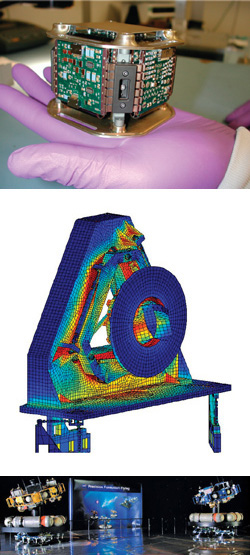
Center image: Simulation of an optical interferometry testbed using Cielo, an integrated structural, thermal, and optical modeling system.
Bottom image: High Precision Formation Flying simulation testbeds.
In order to develop and maintain its forward-looking technology strategy, the Jet Propulsion Laboratory (JPL) periodically reviews key technologies that are critical to the success of NASA’s Science Mission Directorate science questions and exploration goals. The Strategic Technology Directions 2009 document is the latest outcome of this review, providing a direction for the development of these critical technologies and illuminating their links to NASA’s science goals and space missions.
The identification of critical technology areas facilitates the communication of JPL’s priorities and needs, prioritizes the acquisition and development of new technology by focusing resources, and provides a context for the development of alliances and partnerships. The document is intended to guide JPL technology work funded by NASA and non-NASA sponsors and direct technology-development investments and related science research.
“Strategic technologies identified in this document represent technology capabilities that the Jet Propulsion Laboratory believes are essential to continuing progress in pursuit of NASA’s and JPL’s mission, national goals and in addressing global concerns,” says Dr. Paul Dimotakis, JPL’s Chief Technologist. “Advancing these technologies, which often push the theoretical limits of performance, presents major challenges,” he says, “not least of which is that these advances require sustaining an environment of imagination and creativity, and a culture of innovation, for decades of dedicated effort.”
Strategic Technology Directions 2009 identifies 10 key technology areas that are essential for JPL’s continuing contribution to NASA’s future success and that should be developed with JPL leadership:
- Large-aperture systems – By combining lightweight apertures with precision deployable structures, larger and more capable apertures can be launched, enabling the design and operation of future missions that improve our understanding of our planet and our universe, and other missions of national interest.
- Detectors and instrument systems – Progress in these areas, which encompass an especially broad set of technologies, requires specialized facilities such as the JPL Microdevices Laboratory for fundamental device research, and for the development of novel, unique and flight-proven detectors and instruments that enhance NASA’s mission.
- Advanced propulsion and power systems enable the next generation of deep-space missions requiring large, energy intensive changes in trajectory, as well as high-performance power sources and energy storage systems for deep-space and extreme-environment planetary surface missions.
- In-situ planetary exploration systems will employ a set of as-yet unrealized capabilities to enable future planetary exploration, whether at the outer planets, Mars, or Venus.
- Survivable electronic and mechanical systems – Nearly all planned planetary and deep-space missions must contend with an extreme environment component, and technology developments in this area will enable reliable operations under extreme radiation, temperature, pressure and particulate conditions.
- Deep-space navigation – Advancements in these technologies will improve spacecraft control and operations, allowing exciting new missions to distant solar system bodies to be accomplished efficiently and effectively.
- Precision formation flying enables a new class of mission architectures with the potential of unprecedented science performance by the precise control of collaborative, distributed spacecraft systems, including multiple spacecraft in formation and fractionated spacecraft.
- Deep-space communications are critical to the success of space missions, which require high-bandwidth data transmission from spacecraft to Earth, spacecraft tracking, and the ability to instruct spacecraft to perform necessary actions. To continue meeting the increasing demand on these systems, NASA’s Deep Space Network must increase its capability by a factor of 10 during each of the coming decades.
- Mission system software and avionics will evolve flight computing capabilities to keep pace with space missions that rely increasingly on autonomous, software-based functionality.
- Lifecycle integrated modeling and simulation are important for technologies and capabilities that are used during both early and later mission development phases – for developing and integrating models and simulations to explore early concepts and also for high-fidelity models coupled with predictive simulations that are used for deep analyses during detailed system design.
The Office of the Chief Scientist and the Technology Working Group at JPL led the development of the Strategic Technology Directions 2009 document, in conjunction with the Office of the Chief Scientist.
Get more information on and download a copy of the Strategic Technology Directions 2009 document.